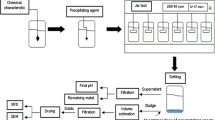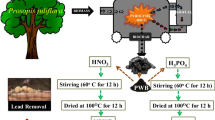Abstract
Natural oyster shells (NOS) and calcined oyster shells (COS) were used to immobilize arsenic (As) from contaminated mine tailings. In addition, a blend of Portland cement (PC)/cement kiln dust (CKD) was used as a stabilizing agent. The Korean Standard Test (KST) method (1 N HCl extraction) was used to evaluate the effectiveness of the treatment. The experimental results showed that COS effectively immobilized As in treated mine tailings. Specifically, an As concentration less than 1 mg L−1 was obtained following COS treatment at 25 and 30 wt%. However, all the samples subjected to NOS treatments failed the Korean warning standard of 1.2 mg L−1 after 28 days of curing. All of the COS-PC treatments were successful meeting the Korean warning standard after 7 days of curing. However, the PC-only treatment failed to meet the Korean warning standard. Similarly, the CKD-only treatment was failed to meet the Korean warning standard after 7 days of curing. However, the COS-CKD treatment showed that when the COS content was greater than 20 wt%, less than 1 mg L−1 of As leachability was obtained. Scanning electron microscopy–energy dispersive X-ray spectroscopy (SEM–EDX) showed needle-like and torpedo-like Ca–As phases in the COS-treated samples suggesting that As was strongly associated with Ca and O. X-ray absorption near edge structure (XANES) analyses confirmed that As(V) was prevalent in the tailings and that there were no changes in As speciation following NOS or COS treatment.








Similar content being viewed by others
References
Bothe JV, Brown PW (1999) Arsenic immobilization by calcium arsenate formation. Environ Sci Technol 33:3806–3811
Boyle RW, Jonasson JR (1973) The geochemistry of arsenic and its use as an indicator element in geochemical prospecting. J Geochem Explor 2:251–296
Cherry JA, Shaikh AU, Tallman DE, Nicholson RV (1979) Arsenic species as an indicator of redox conditions in groundwater. J Hydrol 43:373–392
Conner JR (1990) Chemical fixation and solidification of hazardous wastes. Van Nostrand Reinhold, New York
Dermatas D, Moon DH, Menounou N, Meng X, Hires R (2004) An evaluation of arsenic release from monolithic solids using a modified semi-dynamic leaching test. J Hazar Mater B116:25–38
Dutré V, Vandecasteele C (1995) Solidification/stabilization of arsenic-containing waste: leach tests and behavior of arsenic in the leachate. Waste Manage 15:55–62
Dutré V, Vandecasteele C (1998) Immobilization mechanism of arsenic in waste solidified using cement and lime. Environ Sci Technol 32:2782–2787
Gougar MLD, Scheetz BE, Roy DM (1996) Ettringite and C-S-H Portland cement phases for waste ion immobilization: a review. Waste Manage 4:295–303
International Centre for Diffraction Data (2002) Powder diffraction file, PDF-2 database release
Jang M, Jung SH, Sang IC, Jae KP (2005) Remediation of arsenic-contaminated soils and washing effluents. Chemosphere 60:344–354
Jang M, Hwang JS, Choi SI (2007) Sequential soil washing techniques using hydrochloric acid and sodium hydroxide for remediating arsenic-contaminated soils in abandoned iron-ore mines. Chemosphere 66:8–17
Jung MC (2001) Heavy metal contamination of soils and waters in and around the Imcheon Au–Ag mine. Korea Appl Geochem 16:1369–1375
Kumarathasan P, McCarthy GJ, Hassett DJ, Pflughoeft-Hassett DF (1990) Oxyanion substituted ettringites: synthesis and characterization; and their potential role in immobilization of As, B, Cr, Se, and V, fly ash and coal conversion by-products: characterization, utilization, and disposal VI. Mater Res Soc Symp Proc 178:83–104
Lee JY, Hong CO, Lee CH, Lee DK, Kim PJ (2005) Dynamics of heavy metals in soil amended with oyster shell meal. Korean J Environ Agr 24:358–363
Lee CH, Lee DK, Ali MA, Kim PJ (2008) Effects of oyster shell on soil chemical and biological properties and cabbage productivity as a liming materials. Waste Manage 28:2702–2708
Lee J-U, Lee S-W, Chon H-T, Kim K-W, Lee J-S (2009) Enhancement of arsenic mobility by indigenous bacteria from mine tailings as response to organic supply. Environ Inter 35:496–501
Material’s Data Inc (2005) Jade, Version 7.1, California, USA
MOE (2002) The Korean Standard Test (KST) Methods for soils (in Korean). Korean Ministry of Environment, Gwachun, Kyunggi
Moon DH, Dermatas D, Menounou N (2004) Arsenic immobilization by calcium-arsenic precipitates in lime treated soils. Sci Total Environ 330:171–185
Moon DH, Wazne M, Yoon I-H, Grubb DG (2008) Assessment of cement kiln dust (CKD) for stabilization/solidification (S/S) of arsenic contaminated soils. J Hazard Mater 159:512–518
Ure AM (1995) In: Alloway BJ (ed) Heavy metals in Soils, Glasgow. Chapman & Hall, Boca Raton
Vandecasteele C, Dutré V, Geysen D, Wauters G (2002) Solidification/stabilization of arsenic bearing fly ash from the metallurgical industry: Immobilization mechanism of arsenic. Waste Manage 22:143–146
Williams JW, Silver S (1984) Bacterial resistance and detoxification of heavy metals. Enzyme Microb Technol 6:530–537
Acknowledgments
This study was supported by the Korea Ministry of Environment as “The GAIA Project No. 173-091-003”. The authors would like to thank Dr. Min Gyu Kim and the members at the Pohang Accelerator Laboratory (PAL), South Korea for their integral help with the XANES analyses. The PC and CKD were provided by Mr. Jeff Fair of LaFarge North America (Coopersburg, PA).
Author information
Authors and Affiliations
Corresponding author
Rights and permissions
About this article
Cite this article
Moon, D.H., Kim, KW., Yoon, IH. et al. Stabilization of arsenic-contaminated mine tailings using natural and calcined oyster shells. Environ Earth Sci 64, 597–605 (2011). https://doi.org/10.1007/s12665-010-0890-y
Received:
Accepted:
Published:
Issue Date:
DOI: https://doi.org/10.1007/s12665-010-0890-y




